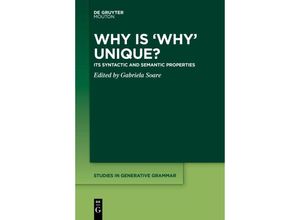Why is 'Why' Unique? Its Syntactic and Semantic Properties considers the behaviour of this
peculiar wh-element across many different languages including Ewe Trevisan Italian Basque
German Dutch Cantonese Mandarin English and Hebrew. In ten original chapters the authors
explore various aspects of why-questions such as the way why interacts with V2 constructions
in Basque with a subject clitic in Trevisan or how its morpho-syntactic make-up determines its
merge position in Ewe to mention but a few. Furthermore a clear-cut distinction is
established between high and low reason adverbials which are subsequently examined in
why-stripping environments in Dutch. Beyond why proper the book explores a special class of
wh-expressions in some in-situ languages which give rise to unexpected why-construals with a
touch of whining force. The objective is to explain the unusual syntactic position of these
wh-expressions as well as their association with peculiar pragmatics. The questions are
addressed for Cantonese: are what-initial sentences genuine questions? To what extent are
Cantonese what-initial sentences similar to how-initial sentences in Mandarin? Beside these
what-as-why questions a special class of rhetorical questions the doubly-marked
interrogatives in Hebrew come under scrutiny. Why is 'why' unique also concerns the interface
with prosody and several experimental studies investigate precisely this aspect.



